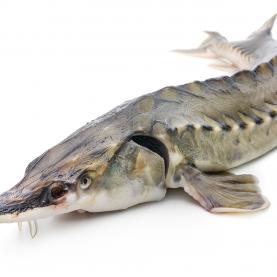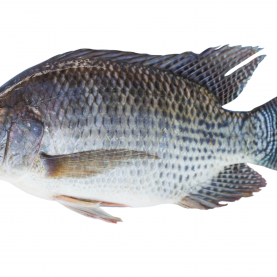Halibut
The halibut is a large flat fish of the Hippoglossoides sub-family and is mainly caught for its tender flesh and to produce fish meal and oil. This species is currently at risk of over-fishing and should therefore be consumed in moderation.
Alliance produits de la mer, 2008. Guide des espèces à l’usage des professionnels. Disponible sur le site : http://www.seafoodchoices.org/resources/documents/FrenchSpeciesGuide_RevisedFinal.pdf, consulté le 05.04.2016.
ALASKA SEAFOOD MARKET INSTITUTE. Le flétan sauvage du Pacifique Nord, Pacific Halibut (Hippoglossus stenolepsis). Disponible sur le site : http://www.alaskaseafood.fr/pages/uploads/pdf/poisson_blanc/fletan_ficheproduit.pdf consulté le 07.04.2016.
GRODEMANGE Anne-Gaëlle, 2010. De l’huile de foie de morue aux huiles de poisson concentrées, riches en acides gras polyinsaturés, Vue d’ensemble des techniques de production d’huile de poisson. OCL VOL. 17 N° 4 JUILLET-AOÛT 2010, pp 219-222. doi: 10.1684/ocl.2010.0323. Disponible sur le site : http://dx.doi.org/10.1051/ocl.2010.0323, consulté le 07.04.2016.
CONSOGLOBE, 2013. EncycloEcolo, Flétan. Disponible sur le site : http://www.encyclo-ecolo.com/Fl%C3%A9tan consulté le 11.04.2016.
A newcomer now under protection
Halibut live in the depths of the Atlantic and Pacific oceans. Although halibut has been fished for a long time in Greenland, intensive fishing is more recent and expanded rapidly in the 1980s. Since overfishing is a threat to the species, catches are now strictly regulated.
A cold water fish
Halibut have elongated bodies, a large mouth, and flanks that vary in colour from dark brown to greenish grey, pale grey or white. The fish is easily recognisable as its two eyes are on the same side of its head. It mainly feeds on other fish and large crustaceans, while it is itself the prey of cod, salmon and seals. Between February and May, females lay eggs in deep waters, at depths of between 700 and 1000 metres, releasing up to 4 million eggs each.
The halibut fishing season runs from March to November, primarily in Greenland, Alaska, Canada, Norway and Japan. In the North Pacific, the only authorised fishing method is trolling or longline fishing. This consists of trailing a main line to which side lines with floats and hooks are attached. Fishermen raise the hooks one by one, retrieve the halibut and release any other fish.
Norway has developed white Atlantic halibut farming, since it is difficult to catch. Although wild white halibut can reach 100 kg, farmed fish are sold at the age of 3 to 4 years, before they reach maturity, when they weigh between 1 and 7 kg.
A family of giants
Halibut, from the Pleuronectidae family, are divided into three main varieties depending on their habitat area: Atlantic halibut (Hippoglossus hippoglossus), Pacific halibut (Hippoglossus stenolepis) and the common black halibut (Reinhardtius hippoglossoides). The common black halibut, also known as 'Greenland halibut', is much fatter than other varieties, but it is also the smallest, rarely exceeding a metre in length. The Atlantic white halibut lives in the same areas as the black halibut, but is much rarer. Little known on the market, it can measure up to 4 metres in length, weigh more than 100 kg and live up to 50 years. The Pacific halibut, which is limited by quotas and so far not under threat, is also a white halibut and lives in the North Pacific. It is one of the largest wild flat fish, reaching up to 2.7 m in length, and can live for over 60 years.
Frozen halibut fillets may only represent a small part of the market, but are particularly appreciated for their firm but tender texture, and delicate flavour. Halibut liver is also sought for its oil, extracted after removing the water and protein through cooking, grinding and centrifugation.
Nutrition
Halibut is rich in vitamins, phosphorous and calcium, and represents an important source of protein (26 g per 100 g of cooked fish) and of omega-3. Halibut liver oil is particularly rich in vitamins A and D.
Alliance produits de la mer, 2008. Guide des espèces à l’usage des professionnels [en ligne]. [Consulté le 05 avril 2016]. Disponible à l’adresse : http://www.seafoodchoices.org/resources/documents/FrenchSpeciesGuide_RevisedFinal.pdf
ALASKA SEAFOOD MARKET INSTITUTE. Le flétan sauvage du Pacifique Nord, Pacific Halibut (Hippoglossus stenolepsis). Disponible sur le site : http://www.alaskaseafood.fr/pages/uploads/pdf/poisson_blanc/fletan_ficheproduit.pdf consulté le 07.04.2016.
GRODEMANGE, Anne-Gaëlle, 2010. De l’huile de foie de morue aux huiles de poisson concentrées, riches en acides gras polyinsaturés. Vue d’ensemble des techniques de production d’huile de poisson [en ligne]. Vol.17, n° 4. Juillet-août 2010. pp. 219-222. [Consulté le 07 avril 2016]. Disponible à l’adresse : http://dx.doi.org/10.1051/ocl.2010.0323
Flétan, 2013. EncycloEcolo [en ligne]. [Consulté le 11 avril 2016]. Disponible à l’adresse : http://www.encyclo-ecolo.com/Fl%C3%A9tan







